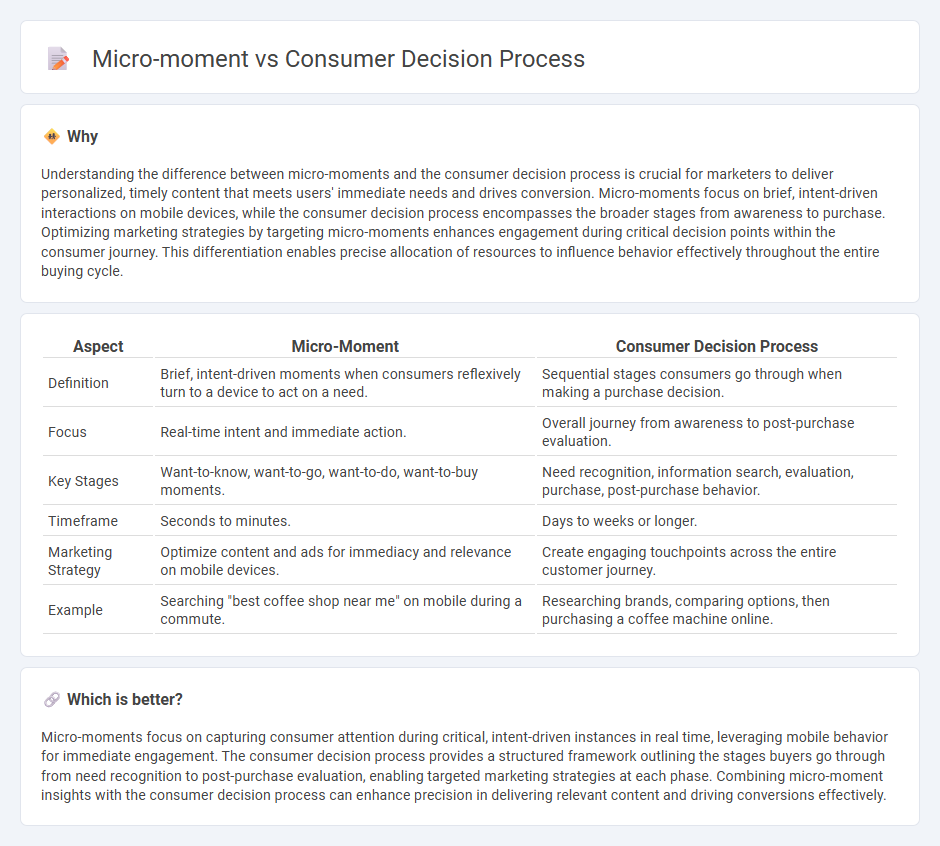
Micro-moments occur when consumers reflexively turn to their devices to act on a need to learn, do, buy, or discover something immediately, shaping the consumer decision process in real time. These brief, intent-rich moments influence how buyers navigate through awareness, consideration, and purchase stages by providing timely, relevant information that drives swift decisions. Explore how leveraging micro-moments can optimize your marketing strategy and enhance consumer engagement.
Why it is important
Understanding the difference between micro-moments and the consumer decision process is crucial for marketers to deliver personalized, timely content that meets users' immediate needs and drives conversion. Micro-moments focus on brief, intent-driven interactions on mobile devices, while the consumer decision process encompasses the broader stages from awareness to purchase. Optimizing marketing strategies by targeting micro-moments enhances engagement during critical decision points within the consumer journey. This differentiation enables precise allocation of resources to influence behavior effectively throughout the entire buying cycle.
Comparison Table
| Aspect | Micro-Moment | Consumer Decision Process |
|---|---|---|
| Definition | Brief, intent-driven moments when consumers reflexively turn to a device to act on a need. | Sequential stages consumers go through when making a purchase decision. |
| Focus | Real-time intent and immediate action. | Overall journey from awareness to post-purchase evaluation. |
| Key Stages | Want-to-know, want-to-go, want-to-do, want-to-buy moments. | Need recognition, information search, evaluation, purchase, post-purchase behavior. |
| Timeframe | Seconds to minutes. | Days to weeks or longer. |
| Marketing Strategy | Optimize content and ads for immediacy and relevance on mobile devices. | Create engaging touchpoints across the entire customer journey. |
| Example | Searching "best coffee shop near me" on mobile during a commute. | Researching brands, comparing options, then purchasing a coffee machine online. |
Which is better?
Micro-moments focus on capturing consumer attention during critical, intent-driven instances in real time, leveraging mobile behavior for immediate engagement. The consumer decision process provides a structured framework outlining the stages buyers go through from need recognition to post-purchase evaluation, enabling targeted marketing strategies at each phase. Combining micro-moment insights with the consumer decision process can enhance precision in delivering relevant content and driving conversions effectively.
Connection
Micro-moments significantly influence the consumer decision process by capturing spontaneous, intent-driven interactions that shape purchasing behavior. These real-time, intent-rich moments provide marketers with opportunities to deliver tailored content and offers precisely when consumers are evaluating, purchasing, or seeking product information. Understanding and optimizing micro-moments enhances engagement and drives conversions by aligning marketing strategies with key stages of the consumer's decision journey.
Key Terms
**Consumer Decision Process:**
The Consumer Decision Process consists of five key stages: need recognition, information search, evaluation of alternatives, purchase decision, and post-purchase behavior, which together guide the buyer's journey in a structured manner. This process emphasizes understanding motivations, preferences, and barriers at each stage to optimize marketing strategies and improve conversion rates. Explore more insights to enhance your approach to consumer behavior analysis.
Need Recognition
The consumer decision process begins with need recognition, a critical phase where consumers identify a gap between their current state and desired state, prompting the search for solutions. Micro-moments, specifically "I want to know" or "I want to buy" moments, capture this need recognition in real-time, leveraging consumer intent through immediate online engagement. Explore how brands optimize content to influence consumer choices effectively during these pivotal instances.
Evaluation of Alternatives
Evaluation of alternatives in the consumer decision process involves comparing different products or services to determine the best match for needs and preferences. In micro-moments, this evaluation occurs in real-time, often triggered by specific moments when consumers seek quick, relevant information on their mobile devices. Explore how micro-moments transform traditional evaluation into immediate, data-driven decision points for deeper insights.
Source and External Links
5 Stages of the Consumer Purchase Decision Process - Shopify - The consumer decision process consists of five key stages: customer need recognition, initial information search, evaluation of alternatives, purchase, and post-purchase appraisal, beginning with the realization of a need and ending with assessing the purchase outcome.
The Consumer Decision-Making Process Defined (With Examples) - Indeed - Consumers go through five stages when making purchasing decisions: acknowledging the need, researching product options, evaluating alternatives, making the purchase, and reflecting after buying, influenced by internal and external stimuli.
A Guide to the Consumer Decision Making Process - Miro - The five key stages are problem recognition, information search, evaluation of alternatives, purchase decision, and post-purchase behavior, with companies leveraging this knowledge to engage consumers effectively throughout the process.
 dowidth.com
dowidth.com